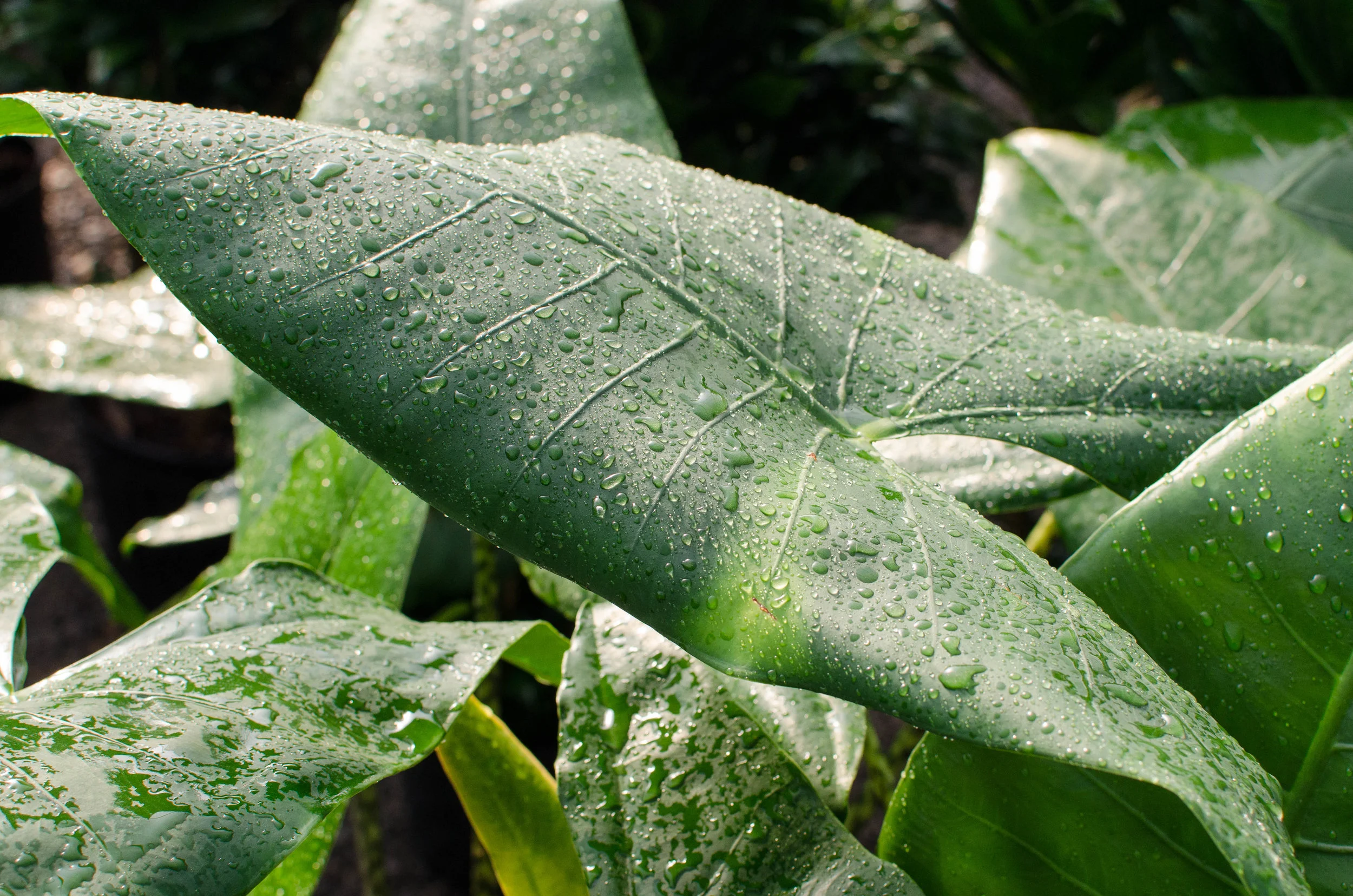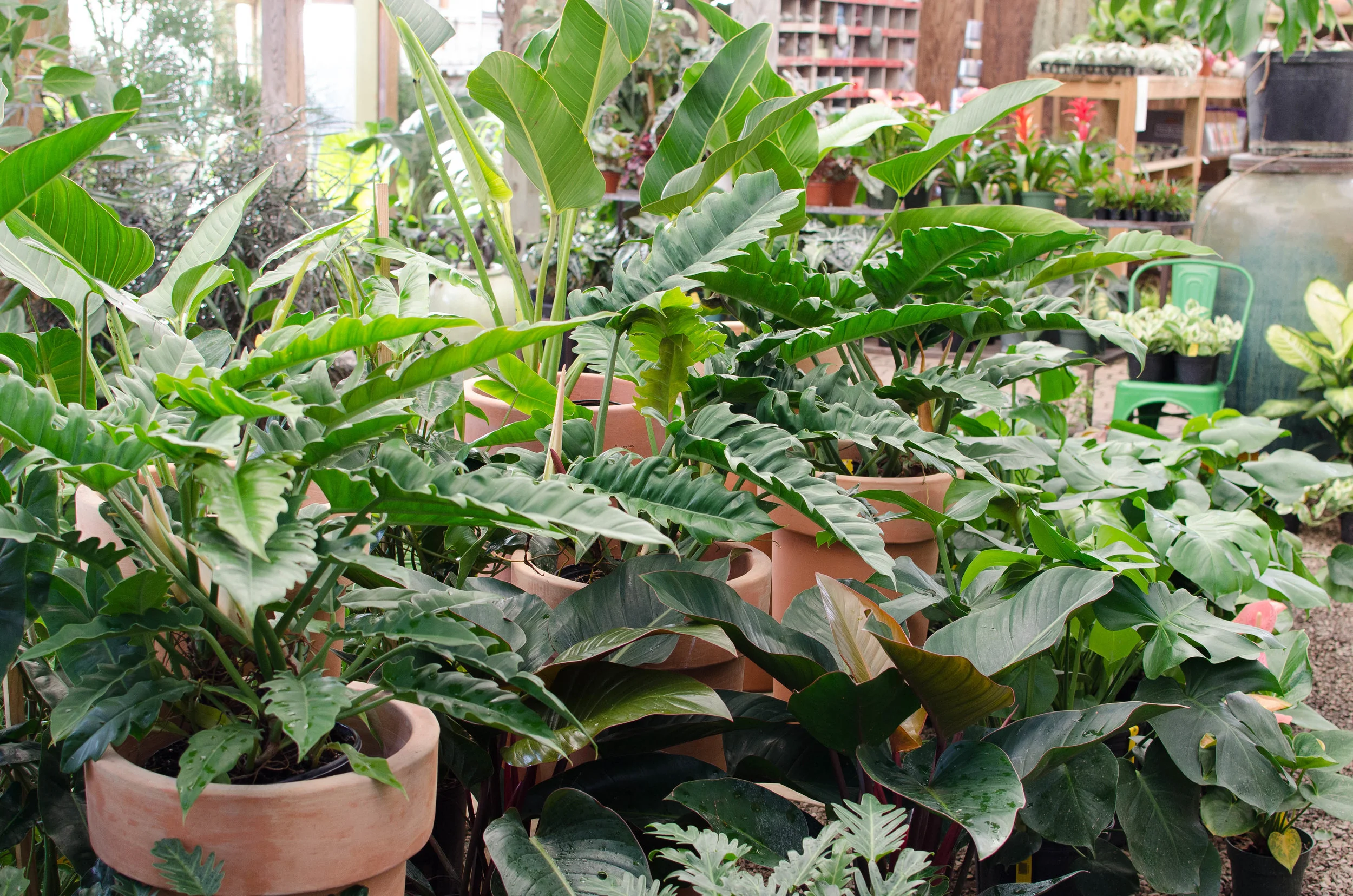Elements of plant care: temperature + humidity
Alocasia zebrina enjoying high humidity and warmth in a greenhouse.
When it comes to figuring out the appropriate humidity and temperature for your plant, it's best to give some thought to where it originated from. If it's not a desert-dwelling succulent or cacti, your houseplant can most likely originally be found growing wild in a tropical forest (there are exceptions, of course, but I find this to be true 9/10 times). Due to the constant rainfall, tropical forests are very humid and warm during the day, and greenhouses mimic that ideal humidity and temperature. Your challenge is to recreate those conditions to the best of your ability. Now, I'm not suggesting you turn your house into a greenhouse (I mean, unless you want to), but there are many things you can do create a proper environment that your plants will thrive in. The easiest step is to maintain household temperatures between 60-85 degrees Fahrenheit, and keep plants away from vents - blasts of cold AC in the summer and dry heat in the winter will make most plants unhappy. They'll let you know, too, because they might droop or drop leaves! If you have your plants outside during the spring and summer, make note of when the temperature starts to dip. I personally bring mine in when the nighttime temps are below 50 degrees.
Depending on where you are located in the world, your house may naturally be more humid or more dry. If you live in Denver, Colorado for example, it's harder to grow tropicals due to the extremely dry air. Those who live in Florida, however, have no problem because the state is about as close as one can get to a rainforest in the US. I'm located in Nashville, TN, a temperate area that has mild winters and humid summers, so my household humidity hovers around 50%.
While many houseplants tolerate standard household humidity, there are a number of species that require higher humidity; I define "high humidity" as being above 60% on a hygrometer (humidity meter). Plants like tropical ferns, alocasias, begonias, fittonias, calatheas, and orchids to name a few require a higher humidity. There are plenty of options for creating optimal conditions for these types of plants, or if your house is dry:
- Placement - If you’re lucky enough to have a bathroom with bright lighting, place your plants there! My dream is to own a house with a large, bright bathroom so I can fill it with as many plants as possible and basically turn it into a jungle. Take note of how steamy it gets when you take a hot shower - your plants with relish it! Kitchens also tend to have higher humidity levels due to the sink and dishwasher running, so that's another great placement area for moisture-loving plants!
- Humidifer - a humidifier creates a constant flow of cool mist that your plants will flourish in. They come in many sizes and price ranges, and may have timers and different intensity settings. Humidifiers especially come in handy during the winter when the heat is running and household air becomes dry.
- Terrariums - a terrarium is an excellent choice for a humidity-craving plant that needs constant "tropical" humidity (say, above 70%). Terrariums are popular right now, so it's easy to find all shapes, sizes, and types that suit your needs and your personal style. There are also plenty of books and websites dedicated to terrarium design! Go search "terrariums" on Pinterest right now and you'll surely be inspired. ;) Compact plants fit best in terrariums, but if you have the space for a glass fish aquarium, any plant can be a terrarium plant.
- Pebble tray - a pebble tray is essentially a dish filled with pebbles/rocks and water. The plant container is placed on top of the pebbles, which lifts the bottom of the container away from the water. Remember, no plant wants to *sit* in water because it will inevitably leave to root rot. The evaporating water beneath the container helps to raise humidity. I like this method when I have a humidity-craving plant that's placed in a more solitary area; for example, I have a large, striking Alocasia zebrina that's not near any other plants or near my humidifier. The pebble tray really helps.
- Plant grouping - grouping a few plants together with similar lighting or watering needs is not only practical and aesthetically-pleasing, it also helps to create a "greenhouse effect," which raises the relative humidity. For example, I have many of my philodendron species grouped together, as well as my Marantaceae family members grouped together.
Plants grouped together to create a greenhouse effect.
The misting myth:
Many plant books and websites will suggest misting your plants with a spray bottle/mister in order to elevate humidity. In reality, the misting only increases humidity for about 15-20 minutes, which is the time it takes for the water to evaporate. Once the water has evaporated, the humidity is gone! In order for this method to be effective, you'd have to mist your plants every 20 minutes, and who has time for that? I definitely don't think misting will harm the plant - it will help keep the foliage free of dust and particles, and sometimes helps keep pests at bay. So, mist at your own discretion, but keep in mind there are better methods for raising humidity if you really want to step up your houseplant care game! Figure out what works best for you & your plant friends.


